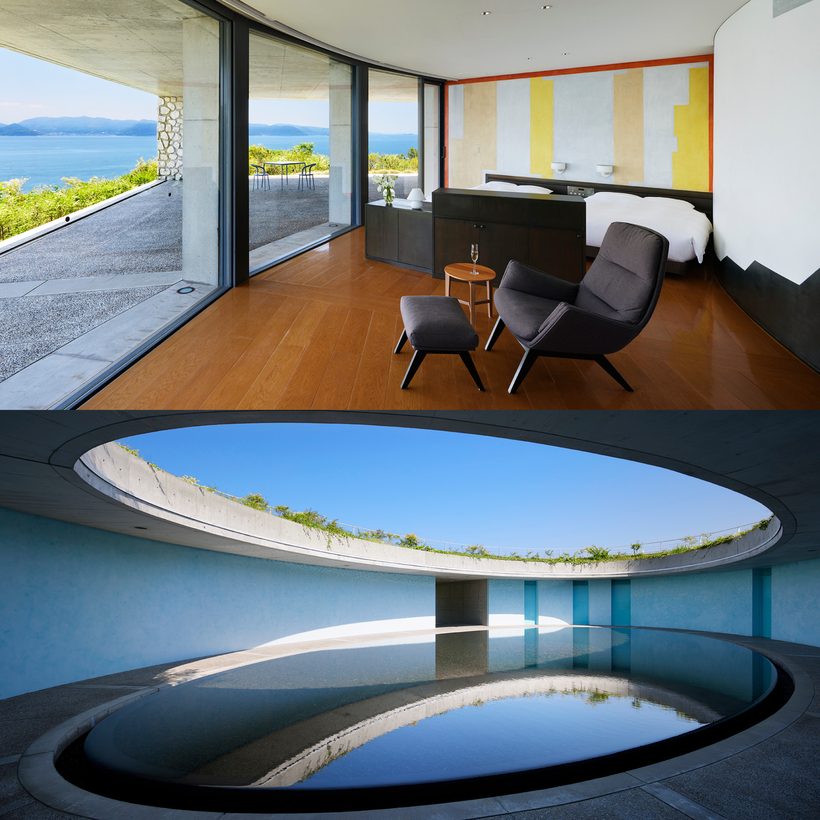It’s close to midnight, and I’m wandering around a world-class museum I have almost entirely to myself when I stop to admire a David Hockney painting on the walls. The Jennifer Bartlett not far away echoes, perfectly, a real boat on a real beach through the windows. Round another corner, 100 neon signs in rainbow colors—“Try and Live,” “Live and Live”—flash injunctions from Bruce Nauman. The Rauschenberg and Basquiat and George Segal are so close, they feel like neighbors, or private possessions.
Then I walk up again to the second floor, pull out my special key for opening a secret door, and, stepping out into the night, push a button. A private “monorail” clanks down to carry me for five minutes up to near the top of a mountain, where I’m staying in one of six rooms gathered around a long, illuminated Tadao Ando reflecting pool.

Climbing up the hill behind my suite, I look out across a heart-stopping 360-degree vista of beaches, inlets, a faraway bridge, the lights of a distant port. Illuminated ships are gliding across the Inland Sea. Nobody else is visible, and I might as well be the master of this fresh green island, its unelected Prospero. The hotel brochure back on my desk advises, “Think, think deeply and sleep.”
What joy to be back again on my sixth stay in what is far and away the most stylish (and unforgettable) hotel I’ve encountered in Japan or almost anywhere else I’ve been over 51 years of constant travel. It’s a hotel in four parts, each of them distinctive, and a radically contemporary creation that opens the door upon exactly the classic sense of intimacy, grace, and attentiveness you would hope to find in a 17th-century Kyoto ryokan.

Benesse House, where I’m staying, is the epicenter of what is known as the “Benesse Art Site Naoshima,” a breathtaking collection of museums and installations scattered across three islands in rural Japan. The hotel is run by the same visionary company that organizes the art projects, as well as the Setouchi Triennale, which will, for the rest of this year, be bringing fresh events and works across 12 islands in all, as well as two neighboring port towns.
Which means that you’re staying in an Ando-designed structure in which every guest room and corridor is itself a kind of gallery, chiming with the Turrell light sculpture down the road and the museum on the neighboring island of Teshima that consists of nothing but drops of running water and two openings to the sky.

The Naoshima project has been attracting the discerning from Soho and Milan for more than 30 years now, but each time I return, there’s something fresh to see. This time: dozens of light, steel Kusama balls clacking away on a pond at the new Valley Gallery, as well as another structure from Ando, his 10th in the area—a new museum that’s due to be a home for Asian art after it opens this spring.
There are other places in which to stay around the island, but if you’re in Benesse House, you’re in the heart of the Naoshima vision, watching from your terrace an Inland Sea that somehow complements the signature Kusama pumpkin down by the pier and passing two giant Walter De Maria spheres inside a cave as you make your way to breakfast.

Soon after the Fukutake publishing company bought up most of the southern half of Naoshima, in the late 1980s, its president invited Ando to design a network of museums across the quiet fishermen’s island. The self-taught architect began with a three-story repository of art—the Benesse House Museum—into which he inserted 10 guest rooms on the second floor.
Suddenly, visitors could enjoy art not just above their beds but in the spaces all around, through which they could wander, undistracted, after the museum closed to the public, deep into the night.
Later, across the road, about seven minutes away by foot, he constructed a building called Beach, allowing guests to stay right next to the lapping waves. Next to it he designed a larger, 41-room structure called Park, with rooms overlooking calm blue waters and public spaces currently furnished with antique tree trunks serving as tables in a small café. On the lawns outside is a transparent glass teahouse.

By then he’d also completed his pièce de résistance, at the top of the mountain behind the museum: the six-room wonder named Oval, routinely referred to as the extraterrestrial spiritual home of some zillionaire in a James Bond movie.
As soon as you arrive at one of Naoshima’s two ports, a uniformed man offers you a deep bow and leads you to the minivan that is the Benesse House shuttle bus. If you’re eager to go straight to the Turrell Skyspace at the end of the road—or to see a Hiroshi Sugimoto glass staircase adorning the shrine in Honmura, Naoshima’s central 17th-century village—he’ll take your bags straight to your room while you lose yourself in the contemplative spaces.
If it’s drizzling a bit, a woman in an impeccable black suit will come running out to the bus as soon as it makes a stop to hand you an umbrella. When you return from the Turrell at closing time, the general manager will pour you a complimentary glass of wine so you can sit on a terrace and look out upon the placid body of water down below before returning to your room.
There’s nothing showy about Benesse House, which manages somehow to be friendly and professional all at once—profoundly Japanese.

The last time I checked in, a card on my desk reminded me of the date when sparrows begin to build their nests, placing us precisely within one of the 72 micro-seasons that guide the Japanese year.
And because the organizers of the Naoshima project are at some level seeking simply to revive long-impoverished islands, and to give busy city dwellers a chance to catch their breath so they can attend to the beauty all around, the rates at the place are a fifth of what you will pay in the overpriced new hotels cropping up all over Kyoto and Tokyo to cater to an explosion of tourists.
For the moment, too, it’s blessedly hard to get to Naoshima; even from Kyoto, 150 miles away, it can take four hours to arrive by bullet train and then slow local train and, finally, infrequent ferry. There’s a small airport in Takamatsu, on the neighboring island, but if you fly there from Tokyo, you’re still at the mercy of the occasional local ferry. The result is that the single narrow road above the sea around Benesse House—you can hear the waves as you walk—is often empty and carless.

Every morning, on a recent stay, my Japanese wife and I took the private monorail down from our mountaintop suite to enjoy a quiet breakfast in the museum, looking out at Sugimoto photographs of horizons hanging upon the outside walls (with another on the cliff below). Hiroko devoured a classic Japanese breakfast of vegetables and fish, while I read the international New York Times over an Aman-worthy Western feast of toast and bacon.
Suddenly, as we were leaving, the elegant deputy manager appeared, though she hoped to be off soon to celebrate her nephew’s graduation from Harvard Business School; she remembered us from a previous visit. The staff makes no fuss over such graciousness; your presence is as matter-of-fact as if you were at home.
Hotels in Japan are generally as charmless as they are flawless. They tend to be immaculate and efficient, but very much by the book. The only exceptions are love hotels, which bombard you with a Vegas-ready explosion of pink rotating beds and rooms shaped like rocket ships.

Benesse House is the rare place that’s not just English-fluent but attuned to an international sense of understated sophistication. There are no TVs in the room, but Bose speakers instead, and terraces where you’re invited to look out on the still lifes that nature is fashioning at every moment. Internet reception can be spotty, but when I went downstairs one night to use a hotel computer, I found myself walking alone beside a huge, eerie, and barely discernible photograph entitled Coffin of Light.
There is, I recently noticed, a spa on-site, but every room is so soothing and silent that you hardly need to step out to find calm. One bright spring afternoon, as I was returning to Oval, I spotted a tiny, enigmatic figure in a hood being bundled out of the hotel toward a waiting car. If it wasn’t Yayoi Kusama, it certainly should have been.
At Benesse House, life and art trade places so seamlessly that you lose all sense of where one ends and the other one begins.
Room rates at Benesse House begin at $225 per night
Pico Iyer is a Columnist at AIR MAIL


